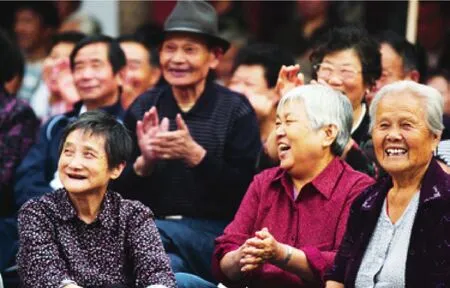An Age-old Old-age Dilemma
2010-10-14ByLIUXINLIAN
By LIU XINLIAN
An Age-old Old-age Dilemma
By LIU XINLIAN
More facilities and caregivers are needed to help China’s elderly enjoy the twilight of their lives

Zhang Lilan, a 65-year-old Beijing resident, was finally admitted to her top choice retirement home at the Beijing No.1 Social Welfare Institution in June after waiting for more than four years.
“I’m lucky. More than 4,000 others are still waiting and some even applied as early as 2004,” said Zhang. “I volunteered to take care of the elderly here years ago, which helped me get enrolled earlier.”
Located between the city’s north third and fourth ring roads, the home is adjacent to several hospitals. It also boasts its own government-approved hospital for seniors, she said.
“The food here is good and the activities are wonderful. I’ve already learned paper cutting and drawing techniques,” she said.
Those 4,000 seniors still waiting to get into the Beijing No.1 Social Welfare Institution are a fraction of more than 150 million senior citizens in China. The country is now facing challenges in caring for its elderly, representing more than 10 percent of its total population.
An aging society
A country is defined as an “aging society” when 10 percent of its population is 60 years old or older, according to international standards. China became an aging society as early as 1999.
In 2009, the number of people aged 60 and above reached 167.14 million, accounting for 12.5 percent of its total population, according to the China National Committee on Aging (CNCA).
The aging group also grows quickly. Last year, China saw the largest annual increase in its senior population, with the number of people aged 60 and above increasing by 7.25 million, said the CNCA. If this growth speed continues, the number of people aged 60 and above could reach a peak of 437 million in 2050.
Moreover, nearly half of the aged people are “empty-nest” parents, that is, one or both parents living by themselves after their children have left the home. CNCA estimated that 49.7 percent of elderly persons in urban areas live in “empty nests.” In rural areas, 48.9 percent of the elderly live alone or with grandchildren since their working children often migrate seeking jobs in cities.
Among the 167 million elderly, 11.4 percent or 18.99 million are aged 80 and above, 9.4 million are disabled and 18.94 million are partially disabled, consisting of a group of more than 40 million who can’t take care of themselves.
Untapped market
Compared with the large aging population, both retirement homes and caregivers are in short supply.
China now has 38,060 retirement homes, with 2.66 million beds, accommodating 2.1 million people, said Dou Yupei, Vice Minister of Civil Affairs.
The number of beds only accounts for 1.59 percent of the total senior population. The proportion is much lower than the 5-7 percent of developed countries, and is even less than some developing countries like Brazil’s 3 percent, according to the Ministry of Civil Affairs.
If 5 percent of the elderly population were to be living in retirement homes, China would need more than 8 million beds. So far, there are only 2.6 million. To make up the difference, at least 5.5 million beds should be added, said Ma Fengli, Vice Director of the Department of Social Security and Silver Industry at the China Research Center on Aging. In doing so, a market worth 300 billion yuan ($45 billion) will be created.
The Ministry of Civil Affairs also predicts that by 2050, when the country’s aging population reaches a peak, the old-age market will be worth 800 billion yuan ($120 billion). Currently, the market scale is only 100 billion yuan ($15 billion).
Even the existing retirement homes still can’t meet the demand of the people living there. One important reason is the lack of caregivers. That’s also a problem facing those elderly in need of home services.
It’s estimated that the number of daily caregivers in China should be at least 10 million. In the United Kingdom, there are around 6 million volunteers or part-time caregivers, about 10 percent of its population. If China wants 1 percent of its population to become full-time or part-time caregivers, the number will be at least 10 million. At present, there are about 200,000 caregivers across the country, according to the CNCA.
The price of peace
But can simply setting up retirement homes and training caregivers bring a boom for the old-age market and relieve the pressure of an aging society in China?
What has lured thousands of senior citizens to the Beijing No.1 Social Welfare Institution is its cheap price. According to its website, a twin-bed room facing south costs 960 yuan ($143) per month per person.
The Beijing No.1 Social Welfare Institution is a retirement home set up by the Beijing Municipal Government. It is a non-profit and financed by the government and therefore has a low price, said Wei Xiaobiao, Vice Director of the Social Welfare Department of the Beijing Municipal Bureau of Civil Affairs. Actually, the cost per bed was at least 2,600 yuan ($388) three years ago.
Government-fnanced retirement homes, being non-proft or running at a cheap price, should give priority to those disabled or those with low incomes, no incomes, or no family. Most of the demands are to be satisfed by privately run ones. However, in sharp contrast to the thousands of applicants to the Beijing No.1 Social Welfare Institution,“most of the private retirement homes are running with high bed vacancy rates,” said Du Peng, professor and Director of Institute of Gerontology, Renmin University of China.
Fushou Retirement Home in Jingzhou City, Hubei Province, now has 15 senior residents following its opening last December. The number is low, especially compared to the 2.8 million yuan ($418,000) investment and more than 150 beds still available. The high vacancy rate has to do with the private home’s price—they charge 1,000 yuan per person per month.
“The price is a little expensive, especially in a small town like ours,” said Hong Yu, Manager of Fushou Retirement Home.
“Most importantly, people here are more conservative than those in big cities like Beijing and Shanghai. And an accepted idea is that finishing one’s life in a retirement home is a miserable ending and means their children are unflial,” said Hong.
“I could not imagine my children sending me to a retirement home, no matter how nice it is. I would rather die in my shabby home than a luxurious nursing home. I will be the most pathetic guy in my friends’eyes if I moved into a retirement home,”said Yang Jianxin, a 56-year-old resident in Jingzhou of Hubei.
But even in Beijing, many old people are not so open-minded as Hong thinks. The Beijing Municipal Bureau of Statistics conducted a survey among senior residents. The results released in September showed 55 percent of respondents said they didn’t want to live in a retirement home at all, and 31.6 percent thought they might choose retirement homes after reaching a certain age. Among those unwilling to live in retirement homes, 18.3 percent said retirement home fees are too high.
Therefore, home services for the elderly will become a mainstream in China, said Yan Qingchun, Deputy Director of CNCA.
Home services for senior citizens will create 500,000 jobs a year, said Yan. But, professional home services will include health care, food, psychological services, etc. Currently, only 10 percent, or about 20,000, are professional caregivers certified by the government. In big cities like Beijing, the proportion is higher, with 2,400 out of 4,000 are certified caregivers. This means the country needs more investments and efforts in training professional caregivers to meet the demand of China’s ever-growing aging population.

LIU JUNXI
